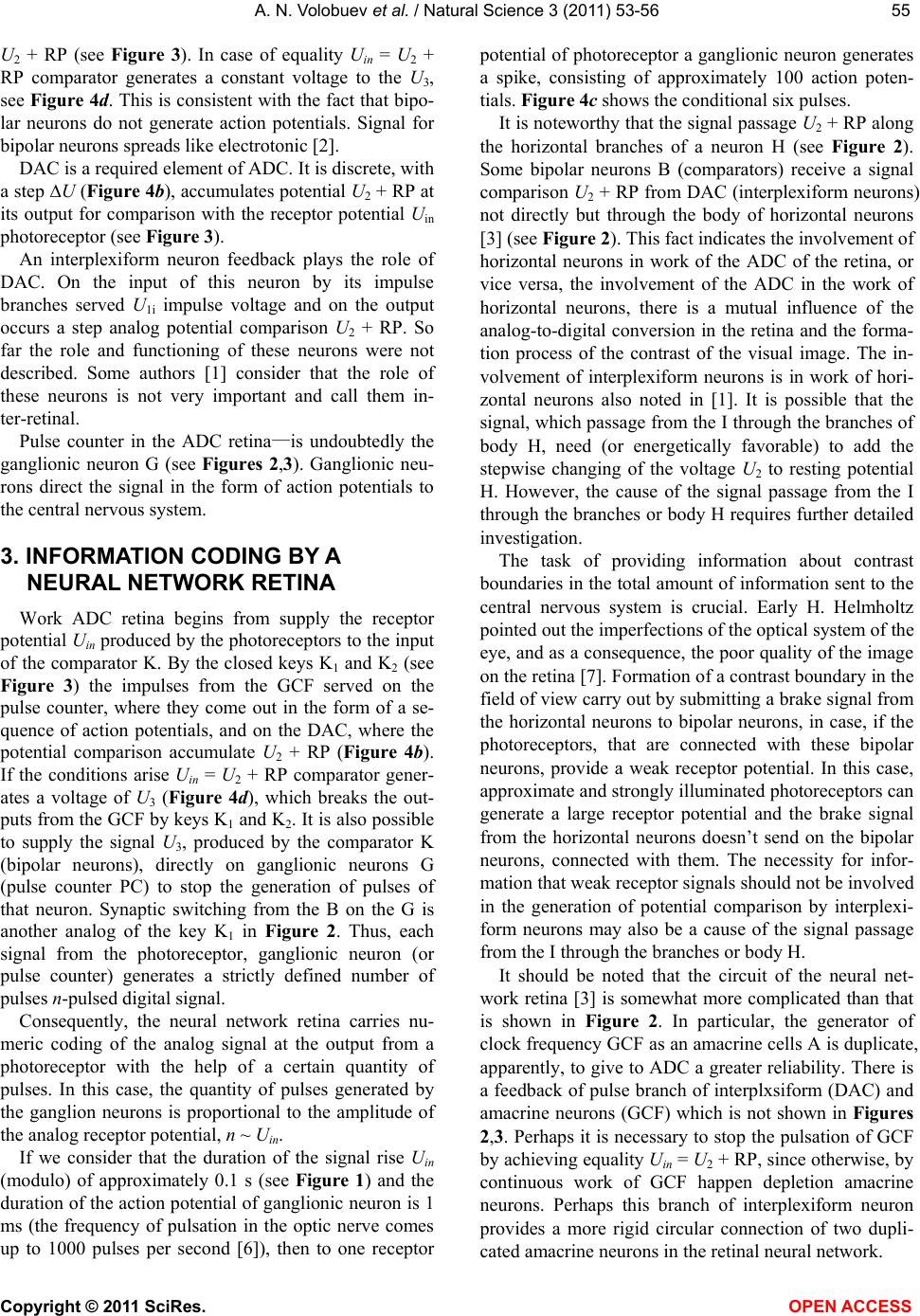
A. N. Volobuev et al. / Natural Science 3 (2011) 53-56
Copyright © 2011 SciRes. OPEN ACCESS
5555
U2 + RP (see Figure 3). In case of equality Uin = U2 +
RP comparator generates a constant voltage to the U3,
see Figure 4d. This is consistent with the fact that bipo-
lar neurons do not generate action potentials. Signal for
bipolar neurons spreads like electrotonic [2].
DAC is a required element of ADC. It is discrete, with
a step U (Figure 4b), accumulates potential U2 + RP at
its output for comparison with the receptor potential Uin
photoreceptor (see Figure 3).
An interplexiform neuron feedback plays the role of
DAC. On the input of this neuron by its impulse
branches served U1i impulse voltage and on the output
occurs a step analog potential comparison U2 + RP. So
far the role and functioning of these neurons were not
described. Some authors [1] consider that the role of
these neurons is not very important and call them in-
ter-retinal.
Pulse counter in the ADC retina—is undoubtedly the
ganglionic neuron G (see Figures 2,3). Ganglionic neu-
rons direct the signal in the form of action potentials to
the central nervous system.
3. INFORMATION CODING BY A
NEURAL NETWORK RETINA
Work ADC retina begins from supply the receptor
potential Uin produced by the photoreceptors to the input
of the comparator K. By the closed keys K1 and K2 (see
Figure 3) the impulses from the GCF served on the
pulse counter, where they come out in the form of a se-
quence of action potentials, and on the DAC, where the
potential comparison accumulate U2 + RP (Figure 4b).
If the conditions arise Uin = U2 + RP comparator gener-
ates a voltage of U3 (Figure 4d), which breaks the out-
puts from the GCF by keys K1 and K2. It is also possible
to supply the signal U3, produced by the comparator K
(bipolar neurons), directly on ganglionic neurons G
(pulse counter PC) to stop the generation of pulses of
that neuron. Synaptic switching from the B on the G is
another analog of the key K1 in Figure 2. Thus, each
signal from the photoreceptor, ganglionic neuron (or
pulse counter) generates a strictly defined number of
pulses n-pulsed digital signal.
Consequently, the neural network retina carries nu-
meric coding of the analog signal at the output from a
photoreceptor with the help of a certain quantity of
pulses. In this case, the quantity of pulses generated by
the ganglion neurons is proportional to the amplitude of
the analog receptor potential, n ~ Uin.
If we consider that the duration of the signal rise Uin
(modulo) of approximately 0.1 s (see Figure 1) and the
duration of the action potential of ganglionic neuron is 1
ms (the frequency of pulsation in the optic nerve comes
up to 1000 pulses per second [6]), then to one receptor
potential of photoreceptor a ganglionic neuron generates
a spike, consisting of approximately 100 action poten-
tials. Figure 4c shows the conditional six pulses.
It is noteworthy that the signal passage U2 + RP along
the horizontal branches of a neuron H (see Figure 2).
Some bipolar neurons B (comparators) receive a signal
comparison U2 + RP from DAC (interplexiform neurons)
not directly but through the body of horizontal neurons
[3] (see Figure 2). This fact indicates the involvement of
horizontal neurons in work of the ADC of the retina, or
vice versa, the involvement of the ADC in the work of
horizontal neurons, there is a mutual influence of the
analog-to-digital conversion in the retina and the forma-
tion process of the contrast of the visual image. The in-
volvement of interplexiform neurons is in work of hori-
zontal neurons also noted in [1]. It is possible that the
signal, which passage from the I through the branches of
body H, need (or energetically favorable) to add the
stepwise changing of the voltage U2 to resting potential
H. However, the cause of the signal passage from the I
through the branches or body H requires further detailed
investigation.
The task of providing information about contrast
boundaries in the total amount of information sent to the
central nervous system is crucial. Early H. Helmholtz
pointed out the imperfections of the optical system of the
eye, and as a consequence, the poor quality of the image
on the retina [7]. Formation of a contrast boundary in the
field of view carry out by submitting a brake signal from
the horizontal neurons to bipolar neurons, in case, if the
photoreceptors, that are connected with these bipolar
neurons, provide a weak receptor potential. In this case,
approximate and strongly illuminated photoreceptors can
generate a large receptor potential and the brake signal
from the horizontal neurons doesn’t send on the bipolar
neurons, connected with them. The necessity for infor-
mation that weak receptor signals should not be involved
in the generation of potential comparison by interplexi-
form neurons may also be a cause of the signal passage
from the I through the branches or body H.
It should be noted that the circuit of the neural net-
work retina [3] is somewhat more complicated than that
is shown in Figure 2. In particular, the generator of
clock frequency GCF as an amacrine cells A is duplicate,
apparently, to give to ADC a greater reliability. There is
a feedback of pulse branch of interplxsiform (DAC) and
amacrine neurons (GCF) which is not shown in Figures
2,3. Perhaps it is necessary to stop the pulsation of GCF
by achieving equality Uin = U2 + RP, since otherwise, by
continuous work of GCF happen depletion amacrine
neurons. Perhaps this branch of interplexiform neuron
provides a more rigid circular connection of two dupli-
cated amacrine neurons in the retinal neural network.